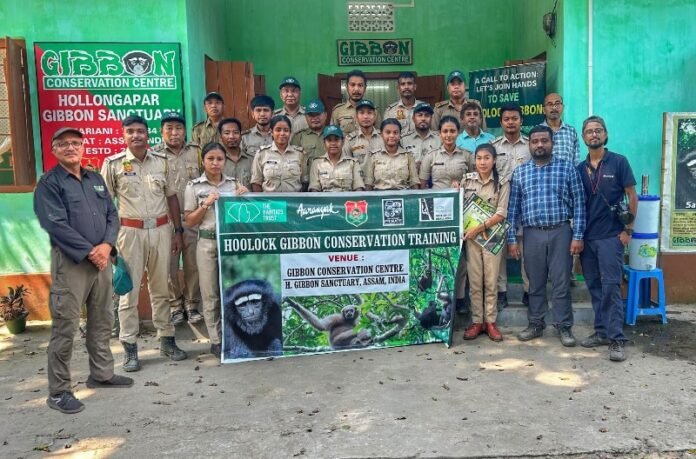Aaranyak, a prominent research, training, and conservation organization based in Northeast India, recently conducted a specialized capacity-building training program aimed at strengthening Hoolock gibbon conservation efforts. The program was organized in collaboration with the Assam Forest Department and sought to enhance the technical expertise of forest officials from Assam and Arunachal Pradesh.
With habitat destruction, poaching, and human encroachment posing severe threats to the species, this initiative was crucial in equipping forest frontline staff with scientific knowledge and field-based skills to aid conservation efforts effectively.
Importance of Hoolock Gibbon Conservation
The Western Hoolock Gibbon (Hoolock hoolock), commonly referred to as the “Ape of India”, is India’s only ape species and is primarily found in the seven northeastern states. These arboreal primates inhabit the tropical evergreen and semi-evergreen forests of the region, particularly south of the Brahmaputra River and east of the Dibang River.
Despite being listed as an Endangered species by the International Union for Conservation of Nature (IUCN) and protected under Schedule I of the Wildlife Protection Act, 1972, their population continues to decline due to:
- Poaching for meat and illegal wildlife trade
- Habitat fragmentation due to deforestation and infrastructure expansion
- Encroachment by human settlements, leading to conflicts
- Limited awareness among forest personnel and local communities
Dr. Dilip Chetry, a leading primatologist and head of Aaranyak’s Primate Research and Conservation Division, emphasized the urgent need for conservation measures: “Hoolock gibbons are facing increasing threats from habitat destruction and human activities. Protecting this species requires well-trained forest personnel who can implement conservation strategies effectively.”
Objectives and Key Components of the Training
The week-long residential training program was structured to provide forest frontline staff with theoretical insights and practical skills to enhance conservation efforts.
Core Topics Covered
The training focused on several key aspects of Hoolock gibbon conservation, including:
- Biodiversity and Conservation in Northeast India – Understanding the region’s ecological significance.
- Primate Conservation with a Special Focus on Hoolock Gibbons – Studying gibbon ecology, behavior, and threats.
- Gibbon Census and Population Estimation Techniques – Training on data collection methods and monitoring techniques.
- Habitat Monitoring and Floristic Studies – Learning how to assess and restore gibbon habitats.
- Gibbon Rescue and Rehabilitation Procedures – Handling and caring for rescued gibbons.
- Use of GPS in Fieldwork – Mapping and tracking wildlife for conservation purposes.
- Wildlife Protection Laws and Their Enforcement – Understanding legal frameworks to combat poaching and illegal trade.
Hands-On Field Training
The program integrated classroom sessions with extensive field exercises, ensuring that participants gained practical experience in conservation research methods.
- Trainees practiced habitat assessments, population monitoring, and data recording.
- They participated in GPS-based tracking to improve mapping and conservation planning.
- Rescue and rehabilitation techniques were demonstrated to enhance emergency response skills.
Participation and Representation
A total of 20 forest officials from Assam and Arunachal Pradesh participated in the training program. This included 14 male and 6 female trainees from various forest divisions and wildlife sanctuaries, such as:
- Doomdoma Forest Division
- Digboi Forest Division
- Dibrugarh Forest Division
- Sivasagar Forest Division
- Jorhat Forest Division
- Mehao Wildlife Sanctuary
- Kamlang Tiger Reserve
The inaugural session, held on February 7, 2025, was chaired by Dr. Dilip Chetry, one of India’s foremost primate conservationists.
Impact and Future Implications
At the conclusion of the training, all participants received:
- Comprehensive study materials, including manuals, Hoolock gibbon books, and conservation posters.
- Participation certificates, acknowledging their successful completion of the program.
Expert Insights on Conservation Strategies
Angsuman Bhuyan, Forest Range Officer of Mariani Range, highlighted the practical application of the training: “The hands-on knowledge gained through this program must be utilized on the ground to safeguard Hoolock gibbon habitats and implement conservation strategies effectively.”
He emphasized that trained personnel are crucial for ensuring habitat protection and enforcement of conservation laws.
The specialized training program organized by Aaranyak serves as a major milestone in conservation efforts for the endangered Hoolock gibbon. By enhancing the capabilities of forest frontline staff, the initiative strengthens on-ground conservation measures and promotes a proactive approach toward biodiversity protection in Northeast India.
Moving forward, continued collaboration between conservation organizations, state forest departments, and local communities will be essential to safeguarding the region’s rich biodiversity. With sustained training programs, habitat restoration efforts, and strict enforcement of wildlife laws, Northeast India can become a model for Hoolock gibbon conservation and ensure the long-term survival of this endangered primate species.




